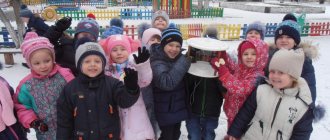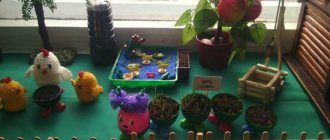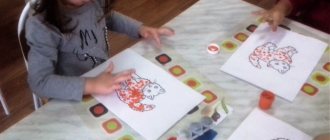Environmental project in the second junior group: “Animals of our forest”
Environmental project in the second junior group
Topic: “Animals of our forest”
Project type:
cognitive - communicative.
By the nature of contacts
: inside the kindergarten, in contact with the family
By number of participants
: with all pupils of the second junior group
By duration:
short.
Author of the project: teacher Zakharkina Natalya Anatolyevna
Problem:
Children know little about the wild animals of our region and their habitat.
Relevance.
The animal world is incredibly diverse and attractive to children. From early childhood, many of the children have this necessary opportunity to contact animals.
However, children do not have sufficient understanding of the lifestyle, habits, nutrition and homes of wild animals. Children do not have a general concept and do not know how to describe objects.
I believe that thanks to the development and implementation of this project, children will become familiar with the description of life and the habits of animals in nature; will receive scientifically reliable knowledge about the animal world; their speech will be enriched, their vocabulary will be replenished
Objective of the project:
nurturing in children a love and caring attitude toward nature, the animals of our region, and their habitat.
Project objectives:
1) Educational: to help deepen and generalize children’s knowledge about wild animals, birds, trees; expand the understanding of the forest and its inhabitants, continue to introduce children to the characteristic features of the seasons, increase speech activity through the use of ICT and the integration of educational areas;
2) Developmental: to develop in children a cognitive interest in the life of the forest and its inhabitants; develop memory, the ability to analyze, draw conclusions, develop the ability to listen to each other.
3) Educational: to cultivate children’s interest in the life of the forest, the ability to behave in the forest, cultivate love, respect for nature, show care and attention to all living things, and develop goodwill.
Expected results of the project:
· Formation of the foundations of environmental culture
· Development of curiosity, creativity, cognitive activity, and communication skills in children.
· Children will develop knowledge about wild animals (hare, fox, wolf, bear), their cubs, habits and habitat.
· Establishing cause-and-effect relationships between lifestyle and habitat.
· Development in children of a sustainable interest in representatives of the animal world - wild animals;
· Active inclusion of parents in the pedagogical process of the preschool educational institution, strengthening interest in cooperation with the kindergarten.
Ecology project “Seasons”, second junior group
Project “Seasons” Second junior group “FAIRY TALE” (children age 3-4 years)
“We are the masters of our nature, and for us it is a storehouse of the sun with great treasures of life. Not only do these treasures need to be protected, they must be opened and shown.” M. Prishvin
Ecology is the science of the relationship between living organisms and their environment. Our task is to teach preschoolers to understand the world around them - ecology (Pestolozzi, Kamensky, Ushinsky, etc.) identified the source of knowledge through nature, as a means of developing the mind, feelings, will, and the all-round development of the child. Children need to be instilled with a love of nature from a very early age. Kids are delighted at the sight of a flower, a butterfly, and at the same time can thoughtlessly crush a running ant. How can we teach them to take care and protect nature, all living things that surround us? V.S. Sukhomlinsky considered it necessary to introduce the child to the natural world around him so that every day he discovers something new for himself in it, so that he grows up as a researcher, so that his every step is a journey to the origins of miracles in nature, ennobling the heart and strengthening the will . It is necessary for children to get used to it and learn to take care of everything they see around them, to take care of everything that surrounds them. We need to help us understand that nature helps us live and makes us happy. We must instill in children an eco-culture and the ability to behave in nature and in the environment.
Relevance of the project
By the age of three, the child’s formation as an individual is completed, awareness of his independence and significance occurs: “I want,” “I won’t,” etc. It is during this period that the baby has a great need for communication and knowledge. At this stage, language becomes the most important condition for preschoolers to become familiar with the world around them and the cultural values of society. Adults are the guardians of the centuries-old experience of humanity, its knowledge, skills, and culture. With the help of an adult, the child establishes various connections in the world around him: he enters into verbal contacts with peers and adults, shares his impressions, takes part in a conversation, and improves the ability to use established forms of polite communication. Preschoolers look at the world around them with great interest, but they don’t see everything, sometimes they don’t even notice the main thing. And if a teacher is nearby, who wonders with them, encourages them not only to look, but also to see, the kids will learn even more. Didactic games, poems, proverbs, riddles will help preschoolers expand their knowledge about the world around them. Fascinating observations on walks, first independent experiments, and developmental activities help young children understand and comprehend the elementary connections of living and inanimate nature in an accessible form. They will create conditions for the formation of moral and aesthetic qualities of the future citizen, a defender not only of himself, his fatherland, but also of all the most beautiful things that NATURE has created. Thus, by attracting children to communicate with nature, to understand the world of plants and animals, we adults contribute to the active development in children of such qualities as kindness, patience, hard work, mercy, curiosity, etc. These traits, laid down in childhood, will become firmly established into a person’s character will become its basis, and then you can be calm for nature and the younger generation. Getting to know nature in kindergarten will help children in the future better understand such sciences as natural history, physics, botany, astronomy, etc. We must teach children to look for and find new things in what they already know and see. As a result of the analysis of the external and internal environment, it was revealed: • Analysis of the external environment - Parents pay little attention to observations of objects and natural phenomena; — Parents do not involve their children in joint work in nature. • Analysis of the internal environment - Little attention is paid to environmental education of children at an early age; — By the age of three, most pupils have a low level of development of environmental concepts; — The idea of the correct ways to interact with nature has not been formed. Feasibility of the project: -Development of integrative qualities: inquisitive, active, responsive; -Development of aesthetic perception of the environment; — Development of morality; — Development of productive activities.
Objective of the project
: formation of ideas about the seasons.
This project will provide teachers with methodological assistance in implementing the following tasks: 1. developing a sense of love and caring attitude towards everything living and inanimate; 2. enriching children’s ideas about the natural world; 3. development of the ability to see the basic patterns of its development; 4. the ability to notice seasonal changes in inanimate nature, the dependence of the life of plants and animals on the season, their adaptability to the environment; 5. development of one’s own cognitive experience of perceiving the world; 6. expanding the prospects for the development of children’s research activities by including them in thinking, modeling and transformative actions; 7. support for children’s initiative, intelligence, inquisitiveness, criticality and independence.
Project duration
: 1 year.
Project implementation stages
: 1. Preparatory (September) -Creation of a developmental environment - Questioning parents - Didactic games - Visual material - Selection of fiction - Card index of finger and outdoor games - Materials for experimentation
2. Practical (October 1 – May 15) Organization of children’s activities
3. Final (May 15-May 31) Determining the result of practical activities with children
4. Post project activities (June - August) Organization of children's activities in the summer
Forms of work
: -OOD - Didactic games - Outdoor games - Finger games -Speech games -Observations in nature -Work in nature -Experimental activities -Productive activities -Reading fiction -Musical - rhythmic movements Expected results of the project: Children Parents Teachers - express feelings of love and caring attitude towards all living and non-living things; - children’s ideas about the natural world are partially formed; - are able to notice seasonal changes in inanimate nature, the dependence of the life of plants and animals on the season, their adaptability to the environment; — the cognitive experience of perceiving the world has been formed; - are included in research activities, in its thinking, modeling and transformative actions; — show initiative, intelligence, inquisitiveness, criticality and independence.
— Interact with teachers on environmental education issues — Conduct observations in nature with children and suppress attempts to abuse natural objects — Involve children in joint work in nature — Conduct active work on environmental education from the second junior group — Use various forms of work — Use modern educational technologies - Disseminate and generalize experience
Contents of the work 1. Autumn Play activities Games-manipulations. Theatrical games. Role-playing games with dummies of vegetables and fruits “Turnip”, “Cooking compote for the bear”, “Doll Masha is preparing a salad”, “Zaykin’s garden”, “Doll goes for a walk”
Communicative activities Didactic games. Finger games. Examination of illustrations, plot pictures “What grows in the garden? ""Is it in the garden in the city" "Find out and name" "What happens in the fall? "What's missing? » “Seasons” “Slices” “Wonderful bag” “Vegetables” “Fruits” “Mushrooms” “Golden Autumn” “Turnip” “We cook compote” “We chop and chop cabbage” “Autumn”
Cognitive - research activities Games with natural materials. Playing with sand. Games with water. Didactic games “Wet - dry”, “What floats”, “Pouring water”, “How many leaves? ", "Find the house of the leaf", "Fold the picture", "Big - small", "Find the same leaf", "Place the vegetables in baskets", Lotto "Autumn", "Vegetables - fruits", "Mushrooms - berries" Observations on a walk for: Wildlife. Inanimate nature autumn flowers trees leaf fall birds insects people's clothing sun sky rain wind puddles soil clouds rain with sleet smoke from chimneys
Motor activity Outdoor games Round dance games “Sun and rain” “Birds and rain” “Falling leaves” “At the bear in the forest” “Vegetable garden”
Labor activity Collecting leaves for the herbarium Cleaning the area
Reading fiction “Leaves are Falling” by M. I. Vensen, “Rain” by E. Blaginin, “In Autumn” by Pleshcheev, “Leaf Fall”, “Cucumber-Cucumber”, “Rain-Rain”, “Turnip”
Musical and artistic activities Singing “Rain”, “Yellow and red leaves”, “We worked in the garden”
Productive activity Drawing Modeling Application “Rain” “Apples” “Mushrooms” “Amanita” “Leaf fall”
2. Winter Play activities Manipulation games. Theatrical games. Role-playing games with figurines of wild animals “Mitten”, “The doll is sick”, “The doll goes for a walk”, “A trip to the winter forest”, “New Year for the animals”
Communicative activities Didactic games Finger games Examination of illustrations, plot pictures Verbal and speech games “Find the picture” “What happens in winter? » “Who hid in the snow” “Dress the doll for a walk” “Seasons” “Winter” “New Year” “Christmas tree” “Warming our hands” “Winter” “Winter fun” “Winter has come to visit us” “What to ride on children" "What did Santa Claus make? ""Snow Maiden with snowballs" "What kind of snowballs? "Let's decorate the Christmas tree"
Cognitive - research activities Games with water Didactic games “Let's freeze” “Warm up” “Colored pieces of ice” “Fold the picture” “How many snowflakes? ""Big and small snowflakes" "What kind of snowball? » “Build a Snowman” Lotto “Winter” “What is white? »
Observations during a walk of: Living nature Inanimate nature Birds Trees Passers-by Weather Snowflakes Snowfall Snow Ice-covered sky Wind Sun Drops
Motor activity Outdoor games Round dance games Speech outdoor games “Little white bunny” “Birds in the nest” “Santa Claus” “Snow is spinning” “On the Christmas tree” “Christmas tree” “Santa Claus” “A little white snow fell...” “Snowflakes”
Labor activity Clearing paths of snow, moving snow to a certain place for the construction of snow structures, feeding birds
Reading fiction M. Poznanskaya “It’s snowing”, O. Vysotskaya “Cold”, V. Khorol “Bunny”, N. Saxonskaya “Where is my finger? ", O. Vysotskaya "The sleigh rolled down", Y. Akim "The Christmas tree is dressing up", Surikov "Winter"
Musical and artistic activities Musical and rhythmic movements “New Year’s round dance”, “Santa Claus”, “How a little white snow fell on a meadow in a field...”
Productive activity Drawing Modeling Application “It’s snowing” “Footprints in the snow” “Rowan” “Snowballs” “Berries for the birds” “Let’s decorate the Christmas tree” “Snowman”
3. Spring Play activities Theatrical games Role-playing games “Zayushkina’s hut” “Journey to the spring forest” “The doll goes for a walk” “The doll is sick”
Communicative activities Didactic games Examination of illustrations, plot pictures Verbal and speech games “Find and show” “Dress the doll for a walk” “Who has the picture? » “Fold the picture” Lotto “Seasons” “Spring” “Spring has come” “What icicles? ""Drip-drip" "What happens in spring" "Find out and name" "What has changed?"
Cognitive - research activities Games with sand Games with water Didactic games “Cake for Mommy” “Sun from palms” “Sinking-floating” “Warm-cold” “How icicles melt” “How many boats are in a puddle? » “Big and small icicles” lotto “Spring” “Fold the picture”
Observations during a walk of: Living nature Inanimate nature Sparrows Swollen buds The work of adults Flowers Birds Insects Weather Sun Snow Snow buildings Melting snow Thaws Wind Rain Sky Streams Puddles Clouds
Motor activity Outdoor games Round dance games Speech outdoor games “Cheerful sparrow” “Step over the puddle” “Sunbeams” “Across the stream” “Birds, once!” Birds, two! » “Hanging a wreath” “Cap” “Spring has come to visit us”
Labor activity: Collecting garbage on the site, cleaning the area from dry leaves, sweeping the path, raking scattered sand back into the sandbox
Reading fiction A. Pleshcheev “Rural Song”, M. Polyanskaya “Dandelion”, Ukr. The song "Vesnyanka", the song "Sun-bucket", the song "Rain", the fairy tale "Zayushkina's hut"
Musical and artistic activities Singing “Sun” music. N. Lukonina, “Winter has passed”, “The sun has a friend” Listening to “April” music. P.I. Tchaikovsky, “Spring Waltz” music. F. Chopin
Productive activity Drawing Modeling Application “Stream” “The grass is turning green” “Icicles” “Dandelions”
4. Summer Play activities Games with natural materials Theatrical games Role-playing games with pine cones, pebbles, etc. “Teremok” “Kolobok” “The doll goes for a walk” “The doll Masha is preparing dinner” “We are going to the dacha” “We are going to relax on the river »
Communicative activities Verbal and speech games Didactic games Finger games “Summer fun” “Summer has come to us” “Who flaps its wings?” “I brought you a flower” “Drip-drip-drip” “Dress the doll for a walk” “Carpet of flowers” “What happens in the summer?” "Summer" "Insects"
Cognitive - research activities Games with water Games with sand Didactic games “Transparent - muddy” “Multi-colored water” “Get a pebble” “I bake, bake, bake” “Wet - dry” “Lotto”, “Fold the picture” “Find a flower for butterflies" "Which tree is the leaf from? » “How many flowers?” "Seasons"
Observations during a walk of: Living nature Inanimate nature Dandelions Trees Insects Birds Flowers Plants Adult labor Sunflower Sun Sky Water Wind Soil Rain Sand
Motor activity Outdoor games Round dance games “Sunshine and rain” “We are cheerful guys” “Sunny bunnies” “At the bear in the forest” “Merry round dance”, “Carousel”
Labor activity: Collecting twigs, sweeping paths, raking sand into a sandbox, watering plants
Reading fiction Nursery rhymes “Like in a meadow”, “The grass is an ant”, fairy tales “Kolobok”, “Teremok”, N. Pavlova, poem “Sunny Bunnies” by A. Brodsky
Productive activity Drawing Modeling Application “Flowers” “Amanita” “Ladybug” “Let’s decorate the butterfly’s wings”
Bibliography:
1. Alyabyeva E.A. "Nature. Fairy tales and games for children", M.: "Sphere", 2012. – 128s. 2. Bagrova L.A. Encyclopedia for children. I'm exploring the world. Moscow: TKO “AST”, 1996. 3. Volina V. Riddles from A to Z. Moscow: OLMA-PRESS, 1999. 4. Volina V. Sayings from Egorka. Moscow: OLMA-PRESS, 1999. 5. Vokhrintseva S., Vokhrintsev S. Demonstration material. Series “The World Around You”: “Autumn”, “Winter”, “Spring”, “Summer” 6. Vokhrintseva S. Methodological manual. Series “The world around us”: “Autumn”, “Winter”, “Spring”, “Summer” 7. Grigorieva O.A., Fesyukova L.B. "Spring. Summer. Demonstration material", M.: "Sphere", 2007. – 32s. 8. Gromova O.E., Solomatina G.N. Poems about the seasons. M., 2004. 9. Yolkina N.V. “Teaching children to observe and tell,” Yaroslavl: “Acad. Development", 1996 – 219 p. 10. Zverev A.T. Ecological games. Moscow.2001 11. Ivanova A.I. “World of Plants”, M.: “Sfera”, 2010 – 210 p. 12. Koptseva T.A. “Nature and the Artist”, M.: “Sphere”, 2001 13. Lykova I.A. “Colored Palms”, M.: Publishing House “Tsvetnoy Mir”, 2011 14. Skrebitsky T.A. “In a forest clearing. Winter", M., "Children's Literature", 1952. 15. Tambiev A.Kh. “Who lives where”, M., “Bustard”, 2007 16. Tikhomirova L.F. Exercises for every day: developing the attention and imagination of preschoolers. Yaroslavl: Academy of Development, Academy, K. 1999. 17. Shorygina T.A. “Conversations about natural phenomena and objects”, M., “Sphere”, 2010. 18. Encyclopedia. Living world. Moscow: “ROSMAN”, 1996
Junior group. Early childhood, nursery. Children 1-4 years old
Short-term project on life safety of young children in nature “Dangerous - not dangerous” Municipal budgetary preschool educational institution “Kindergarten No. 15”
Smolensk Educator: Borisova Natalya Nikolaevna Smolensk 2021
“Dangerous - not dangerous”
Relevance. One of the areas of development and education of children is social and communicative...
Project "Ecolyats - preschool children" in an early age group As part of the project " Ecolyats - preschool children "
in the MADO "Kindergarten No. 8
"Sunny City"
in the city of Engels, Saratov region, in group No. 1 various
environmental : Conversations: "Feed the birds in winter"
,
"Rules of behavior in the forest"
. All these activities allow...




